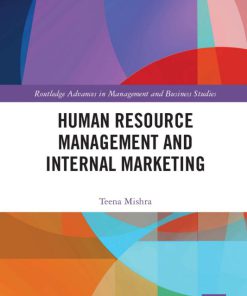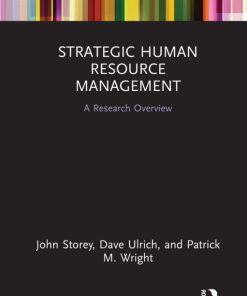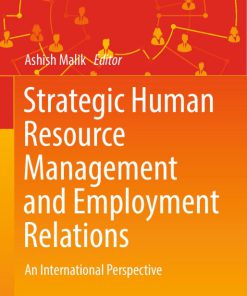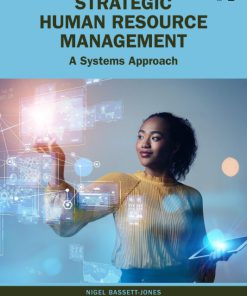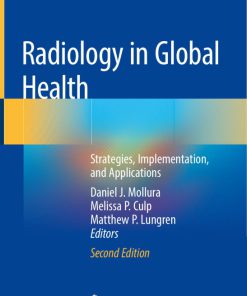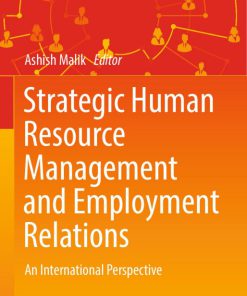Human Resource Management in a Post Epidemic Global Environment Roles Strategies and Implementation 1st Edition by Tanusree Chakraborty, Nandita Mishra, Madhurima Ganguly, Bipasha Chatterjee ISBN 9781000637762 100063776X
$50.00 Original price was: $50.00.$25.00Current price is: $25.00.
Authors:Tanusree Chakraborty , Series:Management [862] , Author sort:Chakraborty, Tanusree , Languages:Languages:eng , Published:Published:Dec 2022 , Publisher:CRC Press , Comments:Comments:This unique volume explores the various aspects of human resources management and challenges that leaders, managers, and employees are facing in dealing with the new normal that is the result of changing workplace conditions and priorities due to the COVID-19 pandemic. With the outbreak of the pandemic and the resulting nationwide lockdowns, business across the globe came to an unexpected halt. This volume looks at the paradigm shift in the workplace ecosystem and how the world has changed in a big way. It discusses HR’s role in organizational growth strategies, employee well-being, and employee mental health during the economic downturn and offers coping strategies that aim to empower human resources through learning and resilience. This book explains strategies that will help in preserving healthy human resources, which are an important component of an organization’s effectiveness and growth. Chapters explain current trends in business and technology, the need for constant upskilling and digital dexterity, managing tech detox, and the way employees should work in the new normal. Chapters in Human Resource Management in a Post-Epidemic Global Environment: Roles, Strategies, and Implementations cover how the role of HR has changed with the pandemic; workplace communication strategies; challenges and opportunities of technology use in work-from-home scenarios; flexible work practices; effective employee retention; preserving employees’ well-being, mental health, and work-life balance; the effect on gender equity; HR challenges in the tourism sector; and much more. Organizations that adopt post-pandemic HR roles and strategies not only have the path to innovation but will also have a competitive landscape in the changing scenario. HR leadership and others at corporations and organizations—both large and small—will find this volume to be a useful resource for discussion, implementation, and innovation. Explores HRM challenges that leaders, managers, and employees face
Human Resource Management in a Post Epidemic Global Environment Roles Strategies and Implementation 1st Edition by Tanusree Chakraborty, Nandita Mishra, Madhurima Ganguly, Bipasha Chatterjee – Ebook PDF Instant Download/Delivery. 9781000637762 ,100063776X
Full download Human Resource Management in a Post Epidemic Global Environment Roles Strategies and Implementation 1st Edition after payment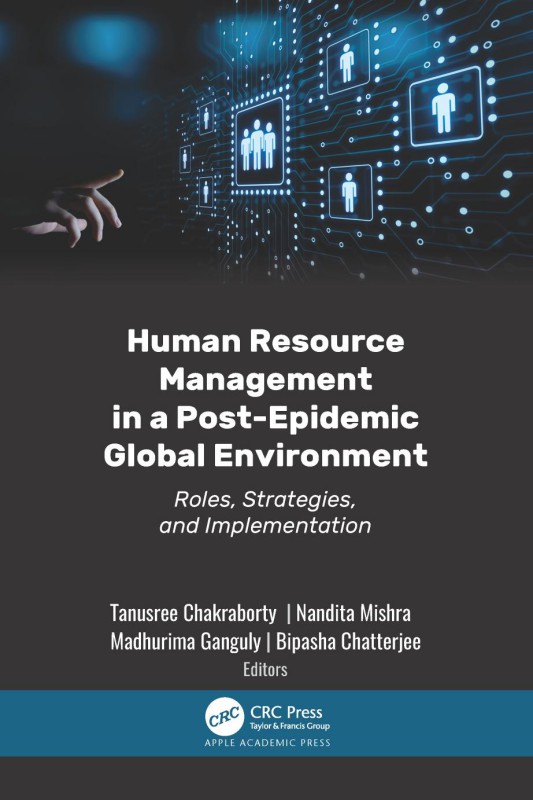
Product details:
ISBN 10: 100063776X
ISBN 13: 9781000637762
Author: Tanusree Chakraborty, Nandita Mishra, Madhurima Ganguly, Bipasha Chatterjee
Human Resource Management in a Post Epidemic Global Environment Roles Strategies and Implementation 1st Edition Table of contents:
Chapter 1 Changing Role of Human Resource Management in the New Normal: A Post-Pandemic Paradigm Change
1.1 Introduction
1.2 Pandemic and Digitization
1.3 Paradigm Shift in HR Role
1.4 New Roles of HR
1.4.1 Counselling and Collaboration
1.4.2 Reinforcing Organizational Values
1.4.3 Innovation and Upskilling
1.4.4 Undisrupted Workflow
1.4.5 Employee Wellness
1.4.6 New Age Policies
1.4.7 Virtual Learning
1.4.8 Work-Life Balance
1.4.9 Workforce Analysis
1.4.10 Keep Employees Motivated
1.4.11 Looking Forward
1.5 Conclusion
References
Chapter 2 Post-Pandemic HR Roles, Strategies, and Implementation: A Gen-Y Perspective
2.1 Introduction
2.2 Post-Pandemic Impact
2.3 Methodology
2.4 Ensuring Right Hr Policies To Manage Covid-19
2.5 Conclusion
2.6 Key Takeaways Of The Chapter
References
Chapter 3 Reimagining Post-Pandemic Communication Strategies at Workplace: A Mindful Shift
3.1 Employee Relations In Organizations Post-Pandemic: An Overview
3.2 Changes In Employee Communication After Covid-19
3.2.1 Digital Transformation Of Internal Communication
3.2.2 Paradigm Shift From Traditional Communication Methods
3.2.3 Importance Of Timely And Factual Information
3.2.4 Greater Focus On Employee Well-Being
3.3 Online Communication: Utilization Of Technology Is A Post-Pandemic Agenda
3.3.1 Availability of Various Communication Channels
3.3.2 Clarify Ways in Which Organizations Will Communicate During A Crisis
3.3.3 Engaging The Groups Working Remotely
3.4 Leaders’ Role In Leading Team Communication in the Post-Pandemic Period
3.4.1 Building A Dynamic And Collaborative Team Structure
3.4.2 Demonstration Of Calm And Optimism During A Crisis
3.4.3 Making Decisions Amid Uncertainty
3.4.4 Compassionate Leadership During Crisis
3.5 The New HR Communication Toolkit Fora Post-Covid World
3.5.1 Ensuring Continuity In Communication
3.5.2 Preserving Organizational Culture In Challenging Times
3.5.3 Establishing Sustainable Leadership
3.6 Updating Employee Communications Plan Frequently: Need of the Hour
3.7 Best Practices in Maintaining Post-Pandemic Crisis Communication Strategy
3.8 Conclusion
References
Chapter 4 Tech Detox and Tech Savvy: Two New Post-Pandemic Verticals of HR
4.1 Introduction: Overview of Tech Detox
4.2 Digital Detox: Exploring The Necessity
4.3 Digitalization And Hr Functions: An Upsurging Trend
4.4 The Benefits Of Digital Hr
4.5 Digital Hr Journey
4.6 Components of Digital Hr
4.6.1 Data And Analytics
4.6.2 Digital Recruitment
4.6.3 A Better Employee Experiences
4.6.4 Employee Self-Service
4.7 Excessive Digitalization: The Hazards
4.8 Digitalization and Impact on Social-Interpersonal Skills
4.9 Pandemic Covid-19 and Digital Detox: Are They Not Contradictory?
4.10 Digital Detox Programs: Are We Heading Right?
4.11 Conclusion
References
Chapter 5 Unveiling the Notion of “Knowledge Hoarding” in a Post-Epidemic global Business Environment
5.1 Introduction
5.2 Knowledge Hoarding—“The Art of Negating”
5.3 “Knowledge Hoarding” vs. Disturbances in the “Online” Workplace
5.4 “Knowledge Hoarding” and the Undercurrent Called “Political Skill”
5.5 Dependence of “Knowledge Hoarding” on Cor Theory
5.6 Discussion—Practicing Managers’ Ways to Neutralize “Knowledge Hoarding”
5.7 The Future of “Knowledge Hoarding”
5.8 Key Takeaways
References
Chapter 6 A Shift in Post-Pandemic Work Strategies: Challenges and Opportunities of Technology Use vis-à-vis Work-from-Home
6.1 Introduction: The Outline
6.2 Snapshot of Covid-19 Challenges
6.3 WFH: The New Normal
6.4 Review of Literature
6.5 The Challenges With Work-From-Home (Wfh)
6.5.1 Communication
6.5.2 Collaboration
6.5.3 Conflict Resolution
6.6 Opportunities With Wfh
6.7 Use Of Technology For Wfh: The Gamechanger
6.7.1 Skype
6.7.2 Webex
6.7.3 Zoom
6.7.4 Google Meet
6.7.5 Microsoft Team
6.8 Research And Findings
6.9 Adapting To The New Normal
6.10 Reckoner Of The Postpandemic Work Life
6.11 Conclusion
References
Chapter 7 The Shift from the New Normal to the Old Normal: Challenges and Solutions
7.1 Introduction
7.2 Methodology
7.2.1 Objectives of the Study
7.2.2 Method
7.2.3 Participants
7.2.4 Inclusion Criteria Of Participants
7.2.5 Tools
7.2.6 Data Analysis and Interpretation
7.3 Major Findings Of The Study
7.4 Discussion
7.5 Suggestions to Cope with Shifting Back to the Old Normal
7.6 Conclusions
7.7 Implications Of The Study
References
Chapter 8 Organizational Growth, Sustainability, and Flexible Work Practices in the Post-Pandemic Era: Overcoming Challenges through Green HRM
8.1 Introduction
8.2 Processes Involved in GHRM
8.2.1 Green HR Operations and Onboarding Process
8.2.2 Green Recruitment
8.2.3 Green Performance Management
8.2.4 Green Development
8.2.5 Green Compensation and Reward
8.2.6 Green Employment Relations
8.3 Advantages Of GHRM
8.4 Challenges of GHRM
8.5 Rationale of the Study
8.6 Methodology
8.7 Findings
RQ 1. How does GHRM promote organizational growth?
RQ 3. How GHRM can facilitate flexible working operations in postpandemic era?
8.8 Direction Of Future Research
8.9 Proposed Model for Successful GHRM Practice in Postpandemic Era from the Perspective of Organization and Individual Employee
8.10 Conclusion
8.11 Key Takeaways
References
Chapter 9 Effective Employee Retention: Are Post-Pandemic Strategies Going to Change?
9.1 Introduction
9.1.1 Employee Retention Defined
9.2 Organizational Level Factors of Employee Retention
9.2.1 Salary and Other Perks
9.2.2 Opportunity for Advancement
9.2.3 Training
9.2.4 Coaching
9.2.5 Mentoring
9.2.6 Organizational Communication
9.2.7 Organizational Support
9.2.8 Work Environment
9.2.9 Organizational Leadership
9.2.10 Organizational Security
9.3 Individual-Level Factors of Employee Retention
9.3.1 Personality
9.3.2 Neuroticism
9.3.3 Extraversion
9.3.4 Openness to Experience
9.3.5 Agreeableness
9.3.6 Perceived Job Satisfaction
9.3.7 Perceived Work-Life Balance
9.4 Employee Retention Strategies in the New Normal
9.4.1 Employee Assistance Program (Eap)
9.4.2 Mental Health Wellness Services
9.4.3 Bridging Communication Gaps
9.4.4 Safety Measures
9.5 Conclusion
References
Chapter 10 Preserving Employees’ Well-Being: An Organization’s Post-Pandemic Imperative
10.1 Introduction
10.2 Demystifying Wellness and Well-Being
10.3 Evaluation Of The Existing Wellness Initiatives
10.4 The Rationale Behind Employee Well-Being Interventions
10.5 Integrated Employee Well-Being Intervention Framework
10.5.1 Need For The Framework
10.5.1.1 To Enhance And Preserve The Employees’ Well-Being
10.5.1.2 To Embrace A Culture Of Well-Being
10.6 Embedding Disease-Related Knowledge In Employees
10.6.1 Diabetes Mellitus Management For Improved Wellness
10.6.2 Hypertension Management for Improved Wellness
10.6.3 Cardiovascular Diseases Management For Improved Wellness
10.6.4 Arthritis Management For Improved Wellness
10.6.5 Kidney Diseases Management For Improved Wellness
10.6.6 Respiratory Diseases Management For Improved Wellness
10.7 Factors Contributing to Employee Wellness
10.7.1 Efficacy Of Exercise
10.7.2 Efficacy Of Healthy Diet
10.7.3 Efficacy Of Good Sleep
10.7.4 Efficacy Of Health Monitoring
10.8 Embedding Well-Being Related Knowledge in Employees
10.8.1 Applying The Core Elements Of Perma Model At Work
10.8.2 Embedding Positive Emotions Related Knowledge in Employees
10.9 Demonstration Of Disease, Wellness, and Well-Being Related Knowledge
10.9.1 Deep Practice, Reflection, Journaling, And Sustenance Of New Behaviors
10.10 Conclusion
References
Chapter 11 Employee Well-Being under the Work-from-Home Culture: Toward an Alternative Framework
11.1 Introduction
11.2 Methodology
11.3 EWB and Contemporary Hrm
11.4 The Social Factory And Ewb
11.5 Well-Being of the Socialized Workers and Employees
11.6 Conclusion: Toward a Humanist Theory of Ewb
11.7 Limitations Of The Study
References
Chapter 12 Post-Pandemic Employee Wellness Focus: An Empirical Study on the Well-Being Aspects of Healthcare Sector Employees
12.1 Introduction
12.1.1 Objective of Study
12.1.2 Employee’s Well-Being and Organizations
12.1.3 Covid-19 And Employee Perspectives
12.2 Methodology
12.2.1 Demographic Profile Of Respondents
12.2.2 Analysis
Personal Protection Equipment
Provision of PPE for All Staff in Presence of COV1D-19 in Hospital
Ability and willingness to work
Willingness to work and health and safety concerns
Fear of staff catching the virus
12.3 Discussion and Conclusion
12.4 Key Takeaways
References
Chapter 13 Work-Life Issues and Stress: Challenges and Coping in the Post-Pandemic Period
13.1 Introduction
13.2 Precovid Stress Management
Work-Life Balance
Stress Management Techniques on and Off the Workplace
13.3 Stress Management In Pandemic Situation
Stress Management and Management Leadership
1 Alarm (Fight-or-Flight)
2. Resistance
3 Coping (Recovery)
4 Adaptation
5 Burnout
13.4 Stress Management In Remote Working Environment
Modern Stress Management Techniques
E-stress Management (Using Artificial Intelligence (AI), Deep Learning, Machine Learning, Mobile Apps)
13.5 Work-Life Balance During Pandemic
13.6 E-Stress Management and Its Challenges for Hr Personnel during Pandemic
Online stress management
App-based stress management
Challenges of E-Stress Management for HR Personnel during Pandemic
13.7 Application of New Normal in the Work Environment
13.8 Post-Covid Stress Management Challenges
13.9 Conclusion
References
Chapter 14 Self-Development among College Teachers during a Pandemic: A Qualitative Study with Reference to West Bengal, India
14.1 Introduction
14.2 Literature Review
14.3 Methodology
Sample
Procedure
14.4 Findings
14.5 Acquiring New Technological Skills
14.6 Enhancing Knowledge Base
14.7 Engaging In Preferred Activities
14.8 Innovative Application
14.9 Conclusion
14.10 Summary
References
Chapter 15 Mental Health and Economic Downturn: Are Post-Pandemic HR Roles and Responsibilities Changing?
15.1 Introduction
15.2 Background
Research Problem
15.3 Findings and Interpretation
Groups 1 to 3: Only students
Groups 4 to 7: Only professionals
Groups 8 to 9: Mixed group of students and professionals
15.4 Conclusion
References
Chapter 16 Covert Casualty in a Crisis: Gender Equity—Empowering Human Resources via Learning, Authenticity, and Resilience
16.1 Introduction
16.2 The Road To Gender Parity Till 2020
16.3 Gender Equity During Crisis Management
16.3.1 From Diversity Resistance To Learning
16.3.2 Austerity—An Inequity Amplifier
16.3.3 The Paradox of Women in Leadership Roles
16.4 The Social Distancing of Women at Work—Are Women Paying a Big Price in 2020?
16.5 The Post-Pandemic HRM Discourse—Emerging Trends
16.5.1 Fostering Authentic Inclusion
16.5.2 Organizational Resilience
16.6 Conclusion
Key Takeaways
References
Chapter 17 A Perspective on Green Human Resource Management (GHRM) During the Post-Pandemic Era
17.1 Introduction: History And Origin Of Ghrm
17.2 Ghrm: Relevance And Significance
17.3 Definition and Purpose of Ghrm
17.4 Advantages and Disadvantages of Ghrm
17.5 Literature on Ghrm Practices
17.6 Ghrm Case Studies Based on Indian Companies
17.7 Ghrm Practices i India
17.8 GHRM, HRM, and Covid-19
17.9 Conclusion
References
Chapter 18 Post-Pandemic Vocational Compass: A Perspective on Career Navigation
18.1 Introduction
18.2 Career Through A New Lens After The Pandemic
18.3 Post-Pandemic up Grading Prerequisite
18.4 Job Seekers Need To Focus On Soft Skills
18.5 Recommendations Toward Post-Pandemic Career Move
18.6 Careers That Are Suitable During This Pandemic
18.7 Covid-19 and Labor Immigrants in Asia
18.8 Pandemic and Employability
18.9 Unemployment and Mental Health
18.10 Are There Ways to Handle the Career Anxieties?
18.11 Preparing for a Post-Pandemic Tomorrow
18.12 Conclusion
References
Chapter 19 Post-Pandemic Business Scenario: Outlining HR Challenges in the Tourism Sector
19.1 Introduction
19.2 Methodology
19.2.1 Analysis of Recovery Themes
Theme 1 Employee Psychological Capital
Theme 2 Communication
Theme 3 Media
Theme 4 Marketing Strategies
Theme 5 Tourist Behavior
19.3 Discussion
19.4 Conclusion
References
Index
People also search for Human Resource Management in a Post Epidemic Global Environment Roles Strategies and Implementation 1st Edition:
importance of human resource management
functions of human resource management
diploma in human resource management
define human resource management




